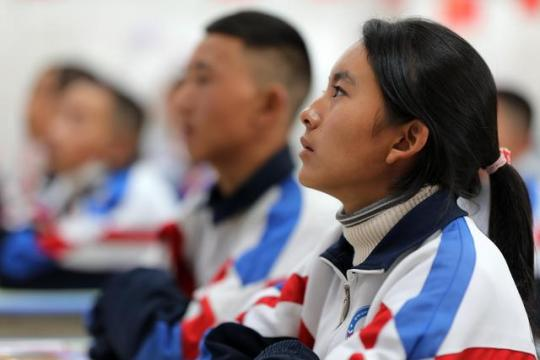
Students at the Lhasa Jiangsu Experimental High School hold a flag-raising ceremony in Lhasa, capital of southwest China's Xizang Autonomous Region, March 10, 2022. /Xinhua
Students at the Lhasa Jiangsu Experimental High School hold a flag-raising ceremony in Lhasa, capital of southwest China's Xizang Autonomous Region, March 10, 2022. /Xinhua
One year ago, Phurbu Drolma received heartening news from her nephew, Tenzin. He had been accepted into a prestigious senior high school after completing three junior years at Lhasa Jiangsu Experimental High School in Lhasa, the capital of China's Xizang Autonomous Region.
"In 2019, following his elementary school graduation, Tenzin decided to continue his education by enrolling at Lhasa Jiangsu Experimental High School, known for its strong teaching staff," said Drolma, who lives in Lhasa's Chengguan District.
Lhasa Jiangsu Experimental High School offers boarding facilities for both junior and senior high school students. Tenzin spent three years there, an experience that helped develop his independence.
Attending boarding school is often a convenient option for both students and parents in Xizang. Drolma, who mentioned Nagqu, one of the most remote and inhospitable areas in Xizang with an average altitude exceeding 4,500 meters, explained that in such a vast and sparsely populated region, it can be challenging for children to commute daily.
"Many parents are engaged in farming and find it inconvenient to pick up their children from school. So schools that offer accommodation services are much more convenient for students who live far from the school," she said.
Even though it's still a few years away, Phurbu Drolma and her husband sometimes discuss their four-year-old child's future education. They have heard that some prestigious middle schools from Beijing are planning to open branches in Xizang.
"Education options may improve in the future. When we were in school, there were no such schools as Lhasa Jiangsu Experimental Middle School," she told CGTN.

Students queue up for meals at the canteen of Nagqu No. 3 Senior High School in Lhasa, capital of southwest China's Xizang Autonomous Region, May 12, 2023. /VCG
Students queue up for meals at the canteen of Nagqu No. 3 Senior High School in Lhasa, capital of southwest China's Xizang Autonomous Region, May 12, 2023. /VCG
Better access to high-quality education
Lhasa Jiangsu Experimental High School is funded by east China's Jiangsu Province, with a total investment of 260 million yuan (about $35.7 million). Since the school's establishment in 2014, Jiangsu has consistently dispatched groups of teachers to bolster local education efforts. Thanks to this support and access to teaching resources, the school's students have consistently achieved the highest average scores in Lhasa's senior high school entrance exams in recent years.
It's not just Jiangsu that has stepped up its support for education in Xizang. Since 2016, Shanghai has been sending teachers to Xigaze City in southwest Xizang annually as part of an educational development program.
Each group of teachers arriving there brings with them Shanghai's advanced educational and teaching concepts, said Tsring Dorje, vice principle of Shanghai Experimental School in Xigaze. He told the local media that to foster collaboration, the school has formed partnerships with schools in Shanghai, allowing teachers to regularly conduct teaching demonstrations with their Shanghai counterparts every semester.
The initiative also offers local teachers the opportunity to advance their studies in Shanghai, with experts in the municipality providing guidance. This enables valuable exchanges among educators, he added.
Meanwhile, online education is promoting the sharing of knowledge and equal access to education by reducing the financial barriers for both teachers and students in remote areas.
In 2019, a cloud education platform was launched by the local education authority, offering learning materials of all curriculums, video courses and tutorials in Tibetan language. Students and teachers can access the top-notch courses and teaching materials of other provinces for free. In just one year, the platform garnered nearly 600,000 registered users and featured more than 120,000 educational resources.

A student listens attentively to the teacher in a classroom in the Lhasa Jiangsu Experimental High School in Lhasa, capital of southwest China's Xizang Autonomous Region, March 10, 2022. /Xinhua
A student listens attentively to the teacher in a classroom in the Lhasa Jiangsu Experimental High School in Lhasa, capital of southwest China's Xizang Autonomous Region, March 10, 2022. /Xinhua
In recent decades, China has made substantial efforts to improve education in Xizang. Since 2016, a total of 800 educational professionals from across the country have been selected to assemble into 20 teams dedicated to developing educational standards in the region.
Additionally, Xizang has implemented an inclusive student financial assistance system that spans all levels of education, from preschool to higher education. The system encompasses both private and public education institutions and extends assistance to all students facing financial challenges.
From 2012 to 2022, the central government invested over 251 billion yuan in Xizang's education system, as stated in a white paper released by China's State Council Information Office on Friday. Currently, the region has 3,409 schools of different types and levels, serving more than 944,000 students.
With the influx of skilled educators and increased investments, children in the plateau region have received a higher quality of education.
Educational informatization have also been improved, with a 100-Mbps broadband network now fully covering primary and middle schools. All primary and middle schools in the area are equipped with multimedia classrooms, according to the regional department of education.




